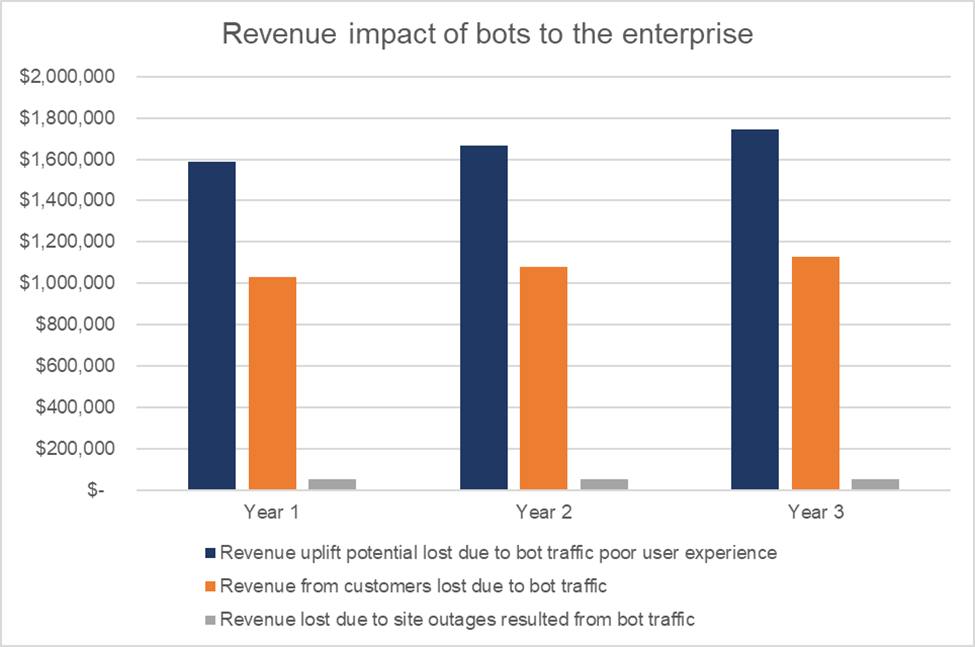Digital transformation efforts continue to accelerate and are pivotal for industries to sustain business and ensure growth. The major challenge is securing applications against malicious bots. Marshalling the resources to achieve this requires explaining the quantitative and qualitative impacts bots have on your business in terms your board and C-Suite will understand.
As a business stakeholder, you know malicious bot attacks are more than a threat to your security infrastructure—they represent a business challenge that must be addressed to preserve your organization’s operations and fiscal viability. Bots jeopardize your customer experience initiatives, risking revenue loss, increasing the cost of gaining new customers, and missing out on opportunities to upsell products and services. And, according the Forrester Total Economic Impact Report, operational teams can waste up to 10,000 hours on manual bot protection.
Indeed, the damages caused by malicious bots are so varied that it can even be a challenge to explain the extensive costs to your organization’s business leaders if they’re not familiar with the threat landscape.
Moreover, every organization is unique. While generic market research may explain the impact of bot attacks and the business benefits of bot mitigation, such research may not reflect the distinct realities of your business. How can you communicate the economic impact of malicious bots in a way that reflects your own business case?
To accomplish this, let’s review a concrete instance of an organization that went through the effort to create such a business case and see what they learned.
Bot Mitigation Case Study
To illustrate the financial value of successful bot management, consider the following real-world example based on a consultation performed by F5 for a major retailer with both in-store and online shopping sites. With more than 30 million user accounts and an average monthly revenue per user account of about $50, the threat of malicious bots for this retailer was hardly a trivial business issue.
Malicious bot activity had led to increased expenditures of time, effort, and resources from their IT and operations teams. Bot exploits included credential stuffing and account takeover (ATO) incidents that had to be resolved, requiring the effort of skilled IT security staff and customer-facing call centers. In addition, on a monthly basis hundreds of these incidents required refunds or credits, adding settlement costs to operational expenses.
Infrastructure costs due to bots were also hurting the business. Even though the company’s infrastructure had ample capacity for its revenue-generating traffic, there was no way to stop the free flow of malicious bots through the infrastructure, which exhausted web-hosting resources from the company’s third-party cloud provider. Scraping bots—bots that crawled the site constantly to extract competitive data—caused site outages and impacted the end-user experience, leading to lost customers, lost revenue, and lost opportunities to upsell.
The retailer worked with F5 through a cost/benefit modeling exercise to calculate the following:
Cost savings: approximately $1 million each year in operational costs savings by more effectively mitigating bots.

Revenue impact: With improved bot management the retailer could save nearly $50,000 in revenue loss prevention per year due to fewer site outages, and about $1 million in revenue loss prevented annually from a decrease in lost user accounts and customer churn attributable to poor user experience.

Also, an uplift of $1.6 million in revenue was realized as a result of improved conversion rates driven by frictionless user experiences and longer stays on the site.
Total benefit: approximately $11 million total economic benefit could be gained over three years through improved bot management.
How can you Benefit from Cost Benefit Modeling?
To better assist organizations in developing a cost/benefit analysis for bot mitigation, F5 has developed a business case modeling tool that takes a broad range of inputs through an inter-active web-based interface. The business case model produces results presented in a language that will allow you to better explain the impact of bot defense to your business leaders.
Examples of costs and revenue data insights include:
- Operational cost savings using metrics related to resolutions of account takeovers caused by credential stuffing
- Operational cost savings using metrics related to incident reporting in call centers
- Capital and operational savings related to infrastructure costs caused by automated traffic
- Revenue impact using metrics related to lost transactions due to site outages caused by bot traffic
- Revenue impact using metrics related to lost customer accounts due to poor experience caused by bots
- Revenue impact using metrics related to improved customer experience and upselling more products and services
Sign-up for a Free Bot Business Impact Consultation
Find out how much malicious bots are costing your business in fraud, infrastructure expenses, employee burnout, and lost customers by signing up for a free and comprehensive bot business impact analysis customized to your business and industry. Or use the free bot impact calculator today for a high-level view of the business impact of bots on your organization.
In addition, to learn how to better communicate the costs that automated bot attacks inflict on your organization and the business benefits of successful bot management, read the white paper From Bots to Boardroom: How Bad Bots Negatively Impact Your Balance Sheet.
